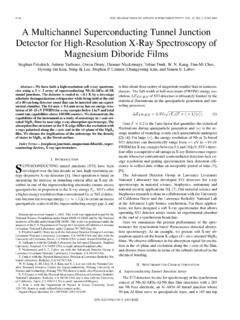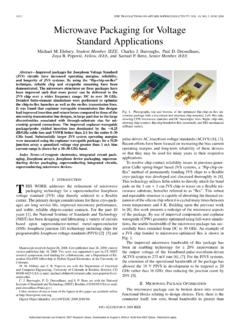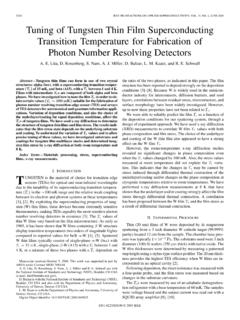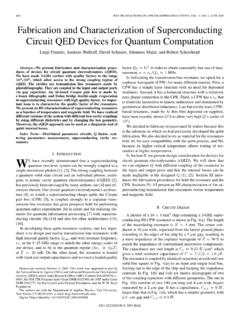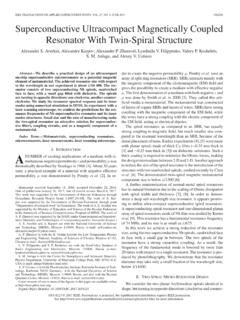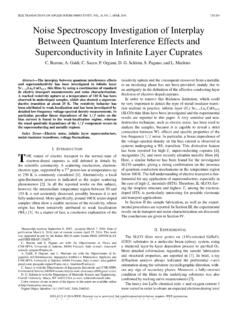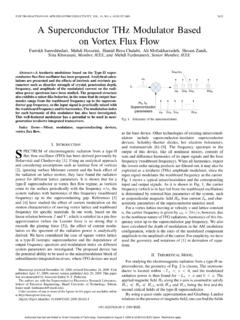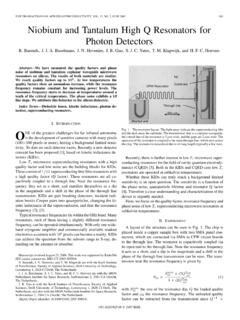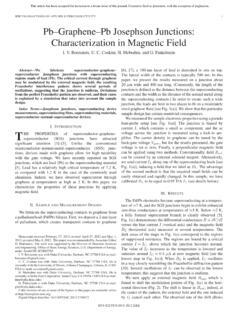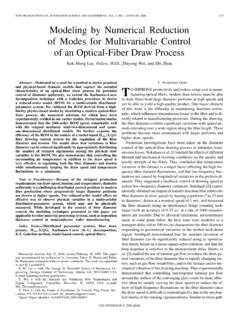Transcription of IEEE TRANSACTIONS ON INDUSTRY APPLICATIONS ... - …
1 ieee TRANSACTIONS ON INDUSTRY APPLICATIONS , VOL. 40, NO. 3, MAY/JUNE 2004887 Reliability Block Diagram Simulation TechniquesApplied to the ieee Std. 493 Standard NetworkWendai Wang, James M. Loman, Member, ieee , Robert G. Arno, Pantelis Vassiliou, Edward R. Furlong, andDoug OgdenAbstract This is one of a series of papers discussing the appli-cation and accuracy of different analysis techniques supportingthe determination of industrial and commercial power systemreliability and availability. There is a need recognized in the powerindustry to identify and utilize a standard tool, or a set of tools, toanalyze the reliability of power systems. Historically, the resultsof applying different reliability methodologies and tools variedsignificantly, and comparisons were difficult.
2 The ReliabilityAnalysis Techniques Working Group of the Gold Book ( ieee 1997) developed a standard network to enable comparisonof analytical techniques. This paper describes the approach ofsimulations via reliability block diagrams as applied to the GoldBook standard network. Reliability indexes of the load pointsare presented, and are compared with ones obtained from othertechniques in the series to determine the Terms Availability, industrial, interruptions, network re-liability, power system, reliability, INTRODUCTIONTHE Power Reliability Enhancement Program (PREP) ofthe Army Corps of Engineers sponsored a surveyeffort to determine the various reliability/availability (R/A)analysis software tools available for utility, commercial, andindustrial electrical and mechanical R/A analysis [1].
3 Theresearch indicated that users were utilizing a wide variety oftools and techniques with different analysis results. Further-more, the only recommended methodology presented in IEEEStd 493 since 1980 was the series and parallel reliabilitymethodology and the minimal cut-set method which estimatedthe frequency and duration of load point interruptions [2].The different approaches identified in [1] include: Zone Branch; Reliability Block Diagram; Event Tree;Paper ICPSD 03 6, presented at the 2003 ieee /IAS Industrial and Commer-cial Power Systems Technical Conference, St. Louis, MO, May 4 7, and ap-proved for publication in the ieee TRANSACTIONS ONINDUSTRYAPPLICATIONSby the Power Systems Engineering Committee of the ieee INDUSTRY Applica-tions Society.
4 Manuscript submitted for review May 7, 2003 and released forpublication March 8, Wang and J. M. Loman are with the GE Global Research Center,Niskayuna, NY 12309 USA (e-mail: G. Arno is with Alion Science and Technology, Rome, NY 13440 USA(e-mail: Vassiliou and D. Ogden are with ReliaSoft Corporation, Tucson, AZ85710 USA (e-mail: R. Furlong is with GE Industrial Systems, Edison, NJ 08817 USA Object Identifier Monte Carlo (and Discrete Event Simulations); Boolean Algebra; FMECA; Cut analytical approaches are applied to the ieee Gold Bookstandard network in a series of papers to determine the accu-racy of their results and how closely they can verify operationalanomalies [3] [5].Other approaches applicable to R/A analysis of industrial andcommercial power systems are the following: Path Set; Fault Tree; Markov Model; Petri paper addresses the simulation approach as applied througha reliability block diagram (RBD).)))
5 Results are compared withones from other ieee GOLDBOOKSTANDARDNETWORKA standard network is required to enable comparisons be-tween different methodologies. After examination of variousactual industrial and commercial power system network con-figurations, the single-line diagram of the Gold Book standardnetwork was defined [3], as shown in Fig. 1. The equipment re-liability data corresponding to each labeled component of thenetwork is listed in Table independent 15-kV primary distribution feeders, asshown in Fig. 1, supply the standard network. There are fourdiesel engine generators at the facility, where two out of fourgenerators are required to meet the network load demands atall times. The reliability indexes of the load points, as shown inFig.
6 1 (Outputs A, B1, B2, C, D, E, F, G1, G2, H, and I), areevaluated by the methodology of simulation via RBD in following assumptions are to be used by any reliabilitymethodology applied to the Gold Book standard network. Failure and repair times are exponentially distributed. Actual cable lengths are indicated on the drawings; modifyfailure rate :actual cable failure ratecable failure rate per rated lengthactual cable length indicated on the drawing M denotes manual operation and is allocated 15 min foractivation. Required generators are two out of $ 2004 IEEE888 ieee TRANSACTIONS ON INDUSTRY APPLICATIONS , VOL. 40, NO. 3, MAY/JUNE 2004 Fig. 1. One-line diagram of ieee Gold Book standard network. The UPSs are redundant. The PDU transformers are redundant.
7 Terminations and splices, while normal for all systems, arenot included on the drawings, and are not included in thecalculations. The assumed breaker failure modes are 50% open and50% of the key reliability indexes for industrial and commercialcustomers is the frequency and duration of load point interrup-tions within their following reliability indexes are evaluated: frequency of load point interruptions (interruptions peryear); annual duration of load point interruptions (hours peryear); average duration of load point interruptions (hours per in-terruption); availability level of power supply to the load METHODOLOGYG enerally, system reliability depends on the: 1) reliabilityand maintainability of its components (including failure andrepair time distributions, failure modes and effects, and envi-ronment effects).
8 2) system design (configuration or topology,dependency, and failure detection); and 3) system behavior(operational characteristics, switching procedure, and mainte-nance services).A reliable equipment data source is key to an accurate anal-ysis. Data sources such as the ieee Gold Book and the PREP database, partly shown in Table I, provide the user with the nec-essary data to evaluate the reliability of power system networkconfigurations. These two equipment reliability data sources arebased on extensive surveys over many years. An understandingof component reliability and maintenance actions provides thenecessary background to determine the availability value of thereliability approach. If actual data recorded from the facility orvendor are available, it is better to proceed with analysis usingthese data.
9 However, component reliability information (equip-ment data) is not a topic of this series of papers. This study fo-cuses on, having component reliability information, and fromthe component reliability information, creating the system levelreliability model, based on system design and industrial and commercial power systems are com-plex (large number of components or equipment, redundantnetworks, complicated operation) and repairable, reliabilityanalysis becomes difficult. In general, no closed-form solutionsto system reliability quantities of interest , there are two steps to find the system reliabilityindexes: 1) constructing the system reliability model and2) analyzing the system reliability model accommodates the system config-uration and its behaviors.
10 Of course, the answer relies on howaccurately the system configuration and its behaviors are under-stood, and what assumptions are made and adopted. It also relieson what modeling method and tool are al.: RELIABILITY BLOCK DIAGRAM SIMULATION TECHNIQUES applied TO ieee STD. 493 STANDARD NETWORK889 Fig. 1.(Continued.) One-line diagram of ieee Gold Book standard RBD method has been found to be a practical reliabilitymodeling method for industrial and commercial power systems[6]. It is a graphical presentation of a system diagram in reli-ability-wise or functional logic; , connecting subsystems orcomponents according to their function or reliability relation-ship. The virtue of RBD is that it is easy to read. It is readilyunderstood by customers who purchase the critical power sys-tems, by the people who sell the systems, by engineers who de-sign and test the systems, and by managers who make decisionson the systems.

